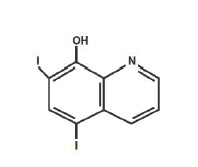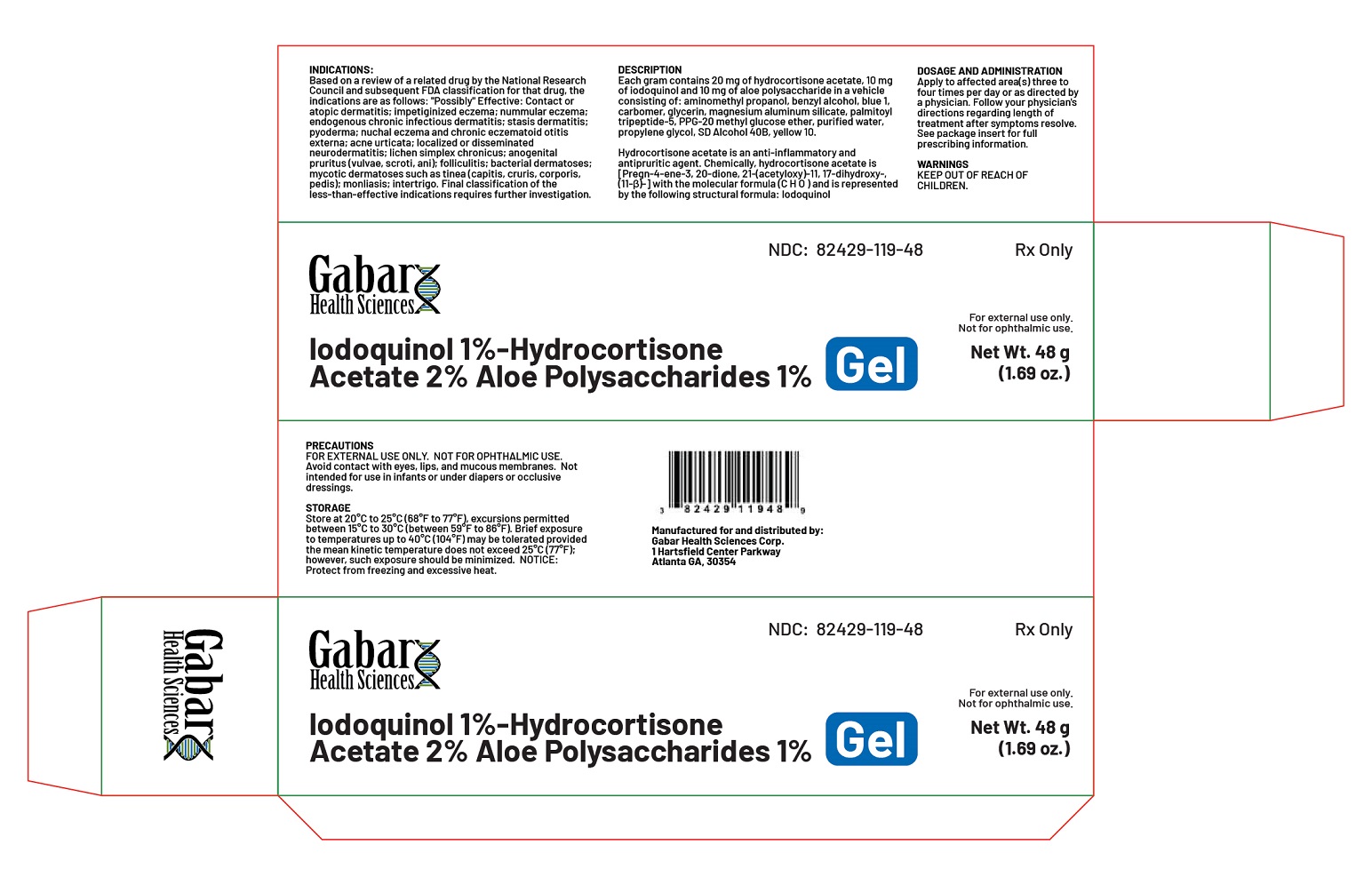Label: IODOQUINOL HYDROCORTISONE ACETATE ALOE POLYSACCHARIDES- iodoquinol, hydrocortisone acetate, and aloe vera leaf gel
- NDC Code(s): 82429-119-48
- Packager: Gabar Health Sciences Corp.
- Category: HUMAN PRESCRIPTION DRUG LABEL
- DEA Schedule: None
- Marketing Status: unapproved drug other
DISCLAIMER: This drug has not been found by FDA to be safe and effective, and this labeling has not been approved by FDA. For further information about unapproved drugs, click here.
Drug Label Information
Updated March 4, 2023
If you are a consumer or patient please visit this version.
- Download DRUG LABEL INFO: PDF XML
- Official Label (Printer Friendly)
- SPL UNCLASSIFIED SECTION
-
DESCRIPTION
Each gram contains 20 mg of hydrocortisone acetate, 10 mg of iodoquinol and 10 mg of aloe polysaccharide in a vehicle consisting of: aminomethyl propanol, benzyl alcohol, blue 1, carbomer, glycerin, magnesium aluminum silicate, palmitoyl tripeptide-5, PPG-20 methyl glucose ether, purified water, propylene glycol, SD Alcohol 40B, yellow 10.
Hydrocortisone acetate is an anti-inflammatory and antipruritic agent. Chemically, hydrocortisone acetate is [Pregn-4-ene-3, 20-dione, 21-(acetyloxy)-11, 17-dihydroxy-, (11-β)-] with the molecular formula (C 23H 32O 6) and is represented by the following structural formula:

Iodoquinol is an antifungal and antibacterial agent. Chemically, Iodoquinol is [5,7-diiodo-8-quinolinol] with the molecular formula (C 9H 5I 2NO) and is represented by the following structural formula:

Aloe Polysaccharides are a concentrated, water soluble subcomponent of Aloe Vera with a mono-sugar ratio of Man : Gal : Glc: 40 : 1.4 : 1.0, linkage of 1-4 ß - linkage, O-Acetyl group of 25% of sugar units, and specific rotation of [α] D= -3.98° at 23.2° C. Average molecular weight is 80,000 daltons. Chemically, Aloe Polysaccharides is represented by the following structural formula:

-
CLINICAL PHARMACOLOGY
Hydrocortisone acetate has anti-inflammatory, antipruritic and vasoconstrictive properties. While the mechanism of anti-inflammatory activity is unclear, there is evidence to suggest that a recognizable correlation exists between vasoconstrictor potency and therapeutic efficacy in humans. Iodoquinol has both antifungal and antibacterial properties.
Pharmacokinetics
The extent of percutaneous absorption of topical steroids is determined by many factors including the vehicle, the integrity of the epidermal barrier and the use of occlusive dressings. Hydrocortisone acetate can be absorbed from normal intact skin. Inflammation and/or other inflammatory disease processes in the skin increase percutaneous absorption. Occlusive dressings substantially increase the percutaneous absorption of topical corticosteroids. Once absorbed through the skin, hydrocortisone acetate is metabolized in the liver and most body tissue to hydrogenated and degraded forms such as tetrahydrocortisone and tetrahydrocortisol. These are excreted in the urine, mainly conjugated as glucuronides, together with a very small proportion of unchanged hydrocortisone acetate. There are no data available regarding the percutaneous absorption of iodoquinol; however, following oral administration, 3-5% of the dose was recovered in the urine as a glucuronide.
-
INDICATIONS
Based on a review of a related drug by the National Research Council and subsequent FDA classification for that drug, the indications are as follows: "Possibly" Effective: Contact or atopic dermatitis; impetiginized eczema; nummular eczema; endogenous chronic infectious dermatitis; stasis dermatitis; pyoderma; nuchal eczema and chronic eczematoid otitis externa; acne urticata; localized or disseminated neurodermatitis; lichen simplex chronicus; anogenital pruritus (vulvae, scroti, ani); folliculitis; bacterial dermatoses; mycotic dermatoses such as tinea (capitis, cruris, corporis, pedis); monliasis; intertrigo. Final classification of the less-than-effective indications requires further investigation.
- CONTRAINDICATIONS
- WARNINGS
-
PRECAUTIONS
FOR EXTERNAL USE ONLY. NOT FOR OPHTHALMIC USE. Avoid contact with eyes, lips and mucous membranes.
Information for Patients
If irritation develops, the use of this product should be discontinued and appropriate therapy instituted. Staining of the skin, hair and fabrics may occur. Not intended for use on infants or under diapers or occlusive dressings. If extensive areas are treated or if the occlusive dressing technique is used, the possibility exists of increased systemic absorption of the corticosteroid, and suitable precautions should be taken. Children may absorb proportionally larger amounts of topical corticosteroids and thus be more susceptible to systemic toxicity. Parents of pediatric patients should be advised not to use tight-fitting diapers or plastic pants on a child being treated in the diaper area, as these garments may constitute occlusive dressings.
Iodoquinol may be absorbed through the skin and interfere with thyroid function tests. If such tests are contemplated, wait at least one month after discontinuance of therapy to perform these tests. The ferric chloride test for phenylketonuria (PKU) can yield a false positive result if iodoquinol is present in the diaper or urine. Prolonged use may result in overgrowth of non-susceptible organisms requiring appropriate therapy. Burning, itching, irritation and dryness have been reported infrequently following the use of topical corticosteroids.
Carcinogenesis, Mutagenesis and Impairment of Fertility
Long-term animal studies for carcinogenic potential have not been performed on this product to date. In vitro studies to determine mutagenicity with hydrocortisone have revealed negative results. Mutagenicity studies have not been performed with iodoquinol.
Pregnancy
Category C
Animal reproduction studies have not been conducted with this product. It is also not known whether this product can affect reproduction capacity or cause fetal harm when administered to a pregnant woman. This product should be used by a pregnant woman only if clearly needed or when potential benefits outweigh potential hazards to the fetus.
-
ADVERSE REACTIONS
The following local adverse reactions are reported infrequently with topical corticosteroids. These reactions are listed in an approximate decreasing order of occurrence: burning, itching, irritation, dryness, folliculitis, hypertrichosis, acneiform eruptions, hypopigmentation, perioral dermatitis, allergic contact dermatitis, maceration of the skin, secondary infections, skin atrophy, striae and miliaria.
- DOSAGE AND ADMINISTRATION
-
STORAGE
Store at 20°C to 25°C (68°F to 77°F), excursions permitted between 15°C to 30°C (between 59°F to 86°F). Brief exposure to temperatures up to 40°C (104°F) may be tolerated provided the mean kinetic temperature does not exceed 25°C (77°F); however, such exposure should be minimized.
NOTICE: Protect from freezing and excessive heat.
- HOW SUPPLIED
- SPL UNCLASSIFIED SECTION
- PRINCIPAL DISPLAY PANEL - 48 g Tube Carton
-
INGREDIENTS AND APPEARANCE
IODOQUINOL HYDROCORTISONE ACETATE ALOE POLYSACCHARIDES
iodoquinol, hydrocortisone acetate, and aloe vera leaf gelProduct Information Product Type HUMAN PRESCRIPTION DRUG Item Code (Source) NDC:82429-119 Route of Administration TOPICAL Active Ingredient/Active Moiety Ingredient Name Basis of Strength Strength IODOQUINOL (UNII: 63W7IE88K8) (IODOQUINOL - UNII:63W7IE88K8) IODOQUINOL 10 mg in 1 g HYDROCORTISONE ACETATE (UNII: 3X7931PO74) (HYDROCORTISONE - UNII:WI4X0X7BPJ) HYDROCORTISONE ACETATE 20 mg in 1 g ALOE VERA LEAF (UNII: ZY81Z83H0X) (ALOE VERA LEAF - UNII:ZY81Z83H0X) ALOE VERA LEAF 10 mg in 1 g Product Characteristics Color green Score Shape Size Flavor Imprint Code Contains Packaging # Item Code Package Description Marketing Start Date Marketing End Date 1 NDC:82429-119-48 1 in 1 CARTON 02/24/2023 1 48 g in 1 TUBE; Type 0: Not a Combination Product Marketing Information Marketing Category Application Number or Monograph Citation Marketing Start Date Marketing End Date unapproved drug other 02/24/2023 Labeler - Gabar Health Sciences Corp. (118401847) Registrant - Gabar Health Sciences Corp. (118401847) Establishment Name Address ID/FEI Business Operations Gabar Health Sciences Corp. 118401847 manufacture(82429-119)


